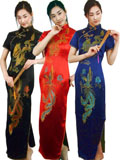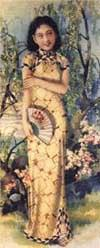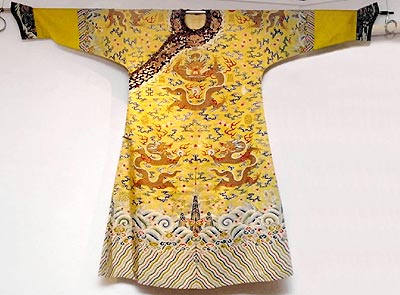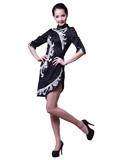Mainland China has transformed culturally due to changes emerging from the traditions continuity. From ancient times, Chinese included clothing as a necessity of life, while the Chinese tradition garments were mainly of bright colors. In 1978, Chinese fashion reformed by having an open door policy on fashion, hence adopting the western culture.
Hence, the Chinese, despite being used to tailor made clothing, started shopping for ready-made clothes, leading to the rise of clothing industries, hence emergence of different clothe brands, colors and designs in the market. For instance, the jeans emerged in China in the late 70’s adopted from the western culture, which was available in different colors and styles.
By the 80’s, there were a variety of different types of clothing styles, which ranged from cotton pullovers, t-shirts, jackets, and skirts among others. In the 90’s, there emerged many clothing stores that aimed at the Chinese customers, especially in Beijing, Shanghai, and Shenzhen among other towns.
China has therefore managed to keep up with the current trends of fashion. For instance, the Chinese clothing manufactures adopt their latest fashion from the traditional clothing. One such example is the “Cheongsam,” which means long dress that is in fashion; however, it has been adopted from the ancient Machu women one-piece dress. The cheongsam Chinese dress is one of the developed fashions from traditional to modern (China info online Para 2)


Some of the traditional clothing included the dragon robe, which was made for an emperor in the Qing dynasty times.

Clothing in early year’s society reflected a culture’s beliefs and values at that particular time; however, today, the society associates clothing with style and fabric. In ancient China, every attire represented a certain aspect of a community. Women often had a jade that was tied to their clothing. The traditional Chinese dresses varied in terms of the social classes that existed; for instance, hanfu was a dress that belonged to the Machu community of China, but was made in different standards (Turner et al 1)
According to Frith, Shaw & Cheng (p61), fashion magazines have contributed greatly to the advancement of fashion in China; for instance, ladies home journal, vogue, her world, female and Cleo are booming in Asia, which focus primarily on fashion and beauty. In ancient China, wooden sandals were famously known as muji; however, they are recently being replaced by plastic or leather shoes (Cultural China Para. 2).
According to Chinese traditional dress (Para. 6), the attire is forsaken and is only retrieved during special occasions; nevertheless, the trends of fashion change now and then and the Chinese attire are modified and developed to attain the modern taste. Below is modern autumn Chinese outfit derived from the traditional Cheongsam dress.

The changing women fashion in mainland china
Each culture has its own values and customs; the Chinese culture is influenced by their mode of dressing among other elements. According to Lu (Para. 12), the Chinese clothing existed in three types; pien-fu, ch’ang-pao & shen-I, which consisted of a tunic, skirt or trouser.
In addition, both dark and bright colors were preferred for the clothing. In addition, today’s fashion designers borrow from the ancient designs while creating new fashions. The author further elaborates that black in the Chinese culture is associated with evil, sadness and disasters among others, hence not a common color in making of dresses.
According to Finnane (p37), the Chinese mode of dressing is irrational especially the men clothing, which resembled pajamas. Nevertheless, the women dresses challenged the westerners, since their clothing culture revealed the female bodies unlike the Chinese women clothing, which concealed other than revealing the bodies.
According to Wang (p1), women mode of dressing reflects much about their originating society. Despite the adopted westernized culture of the in China, especially on women fashion, the author emphasizes that the Chinese still maintain their culture in the long run. Dressing mode can be seen as an ethical element in some societies; however, the Chinese women dressing fashion since 1949 to date has changed.
According to Wang (p2), women of ancient China in the Mao’s era were constantly under the control of their husbands, and therefore, their dressing code was presentable. In addition, at that time, all the Chinese dressed in the same color. However, today, Chinese women have the freedom of adapting any form of fashion without fear of criticism.
The author further adds that the media has played a vital role in attracting women to the fashion world. This is as a result of glamorous magazines, which are widely distributed in China, hence enticing the Chinese women into becoming more modernized.
Hence, the question that arises is whether the Chinese women will become fully westernized or they will retain some of their culture. Nevertheless, it is evident that there is a great change in fashion since Mao’s era.
According to Wang (p5), women in mainland China were deprived the right for education, however, when the Qing dynasty ended in the early 90’s, many social reforms occurred; for instance, women who were obliged to wearing long skirts started shortening them. Qipao, a modern dress, was preferred by many Chinese women, and was adopted from the western culture.
The author further adds that the media has played a huge role in fashion changes among women in mainland China. First, the media presents thinness as an ideal female body, hence resulting to female dissatisfaction in their own bodies. This is evident in fashion magazines.
Therefore, as many young Asian women read these magazines, they desire and imitate what they see and read with an aim of fitting in the modern world (p45). However, the media and magazines have been of great negative impact on the growing generation, as they do not want to be attached to their original culture, instead, they want to imitate and fit in the current culture.
However, does this modern culture have positive or negative attitudes? A study conducted by Wang revealed that Chinese women addicted to fashion magazines work hard to attain certain clothing in the magazine.
Nevertheless, current fashion is not only about the clothing’s; it also entails different hairstyles, thin bodies among other elements, therefore leading to many young women desiring the “perfect” lifestyle. Moreover, they are determined to do anything in order to attain the perfect bodies, which could be dangerous, such as induced vomiting, diet pills among others (Tuner, et al).
The images portrayed by the media especially the magazines have both positive and negative effects. According to Li & Hung (p10), feminine changes are evident in magazines and through advertising due to their target in women.
The author further adds that the number of magazines has increased in China, most targeting women, and the magazines industries use female icons to attract more women into reading the magazines. This matter creates room for the question of whether this high influence of fashion magazines will draw all the Chinese women to westernization, or they will be left with any Chinese culture to embrace.
According to Karan & Feng (p35), some women magazines in Asia have been criticized for contributing to women dissatisfaction in their looks by revealing that the ideal beauty consists of certain kind of fashions, a certain size of body among other elements. Such issues are the negative outcomes of the media that act as a drive to abandoning one’s culture in an attempt to fit in the “ideal “life.
In conclusion, it is evident that Chinese women have embraced the western and modern culture. There is a great difference comparing the Mao era with the current trends of fashion. In addition, the media has played the biggest role in enticing women to change and keep up with the current trend of fashion.
Works Cited
China info online. China info online. 2010. Web.
Chinese moods. “Latest Chinese Clothing and Chinese Products Safari at Chinesemoods.” Chinese moods. 2004. Web.
Chinese traditional dresses. Country Facts. 2010. Web.
Cultural China. Traditions – Clothing and Ornaments. Cultural China. 2011. Web.
Finnane, Antonia. Changing clothes in China: fashion, history, and nation. NY: Columbia University Press Publisher, 2008.
Frith, Katherine, Shaw, Ping and Cheng, Hong. “The Construction of Beauty: A Cross-Cultural Analysis of Women’s Magazine Advertising.” International Communication Association. 2005. Web.
Karan, Kavita and Feng, Yang. “The global and local influences in the portrayal of women’s roles: Content analysis of women’s magazines in China.” Journal of Media and Communication Studies, Vol. 3(2), 2011, pp. 33-44. Web.
Li, Stella and Hung, Kineta. “Images of the Contemporary Woman in Advertising in China: A Content Analysis.” Journal of International Consumer Marketing, Vol. 19, Issue 2, 2006, pp. 8-28. Web.
Lu, Yang. “Chinese Clothing – Five Thousand Years’ History.” Cultural essentials; explore Chinese culture. 2004. Web.
Turner, Sherry et al. The influence of fashion magazines on the body image satisfaction of college women: an exploratory analysis. 1997. Web.
Wang, Xiaolan. Changing face: the evolution of Chinese women’s dress and appearance. 2005. Web.